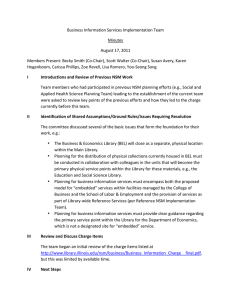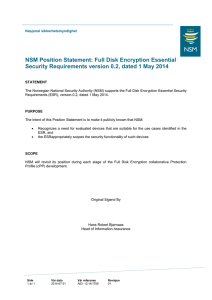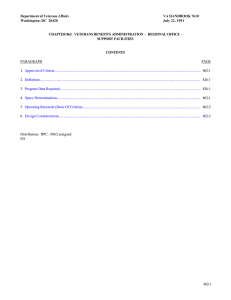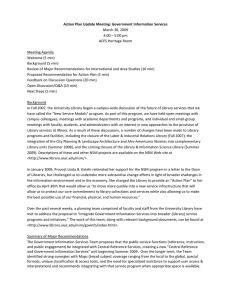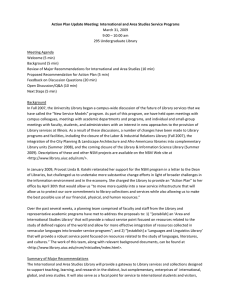Department of Veterans Affairs PG-18-9: Space Planning Criteria Veterans Health Administration
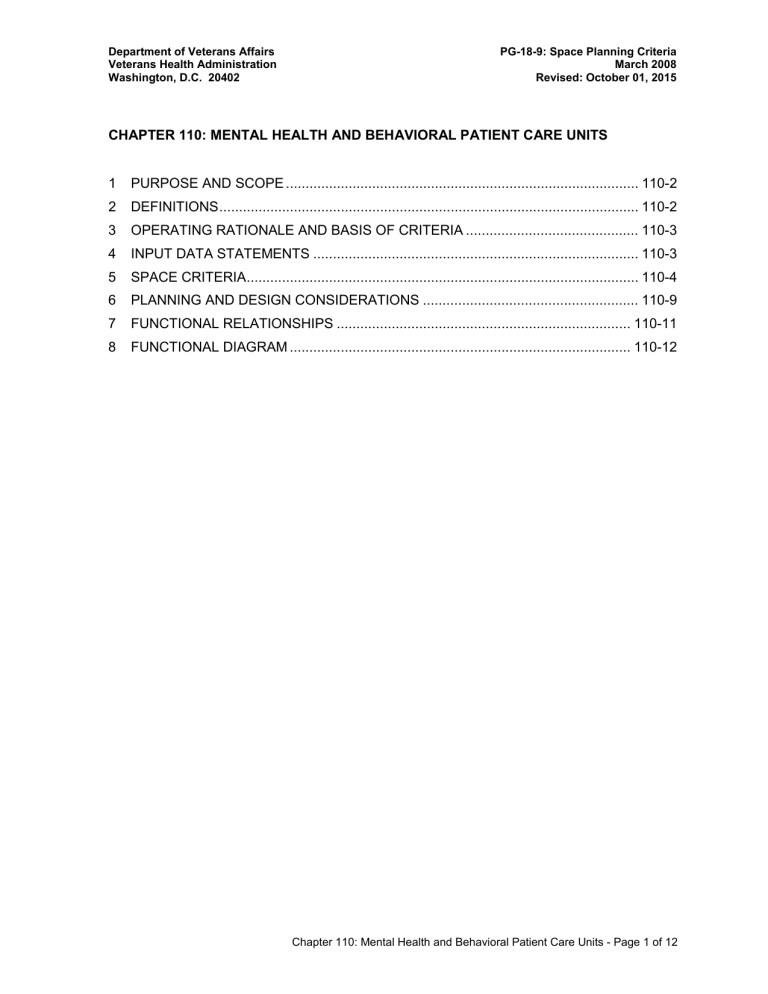
Department of Veterans Affairs
Veterans Health Administration
Washington, D.C. 20402
PG-18-9: Space Planning Criteria
March 2008
Revised: October 01, 2015
CHAPTER 110: MENTAL HEALTH AND BEHAVIORAL PATIENT CARE UNITS
3 OPERATING RATIONALE AND BASIS OF CRITERIA ............................................ 110-3
6 PLANNING AND DESIGN CONSIDERATIONS ....................................................... 110-9
Chapter 110: Mental Health and Behavioral Patient Care Units - Page 1 of 12
Department of Veterans Affairs
Veterans Health Administration
Washington, D.C. 20402
PG-18-9: Space Planning Criteria
March 2008
Revised: October 01, 2015
1 PURPOSE AND SCOPE
This document outlines space planning criteria for Chapter 110: Mental Health and
Behavioral Patient Care Units. It applies to all medical facilities at the Department of
Veterans Affairs (VA).
A Mental Health and Behavioral Patient Care Unit is an inpatient mental health program that provides inpatient accommodations, delivery of health care, direct supportive facilities, and institutional services. Mental Health programs include Psychiatric,
Substance Abuse, Drug Abuse, and Alcohol Dependency treatment.
2 DEFINITIONS
Departmental Conversion Factor: A parameter, determined by the VA for each 7610 chapter, used to convert the programmed Net Square Foot (NSF) area to the Department
Gross Square Foot (DGSF) area. The Departmental Conversion Factor for this chapter is
1.65.
Full-Time Equivalent (FTE): A staffing parameter equal to the amount of time assigned to one full time employee. It may be composed of several part-time employees whose total time commitment equals that of a full-time employee. One FTE equals a 40 hours per week.
Functional Area: The grouping of rooms and spaces based on their function within a clinical service. Typical Functional Areas are Reception Areas, Patient Areas, Support
Areas, Staff and Administrative Areas, and Residency Program.
Input Data Statements: A set of questions designed to elicit information about the healthcare project in order to create a Program for Design (PFD) based on the criteria parameters set forth in this document. Input Data Statements could be Mission related, based in the project’s Concept of Operations; and Workload or Staffing related, based on projections and data provided by the VHA or the VISN about the estimated model of operation for the facility. This information is processed through mathematical and logical operations in VA-SEPS.
Isolation / Restraint: A method of involuntary restriction, chemical or physical, of an individual's freedom of movement, physical activity, or normal access to his /her body.
Isolation / Seclusion: A short-term occupancy by any patient observed to be violent, suicidal or requiring additional direct supervision; the involuntary confinement of a person in a locked room (JCAHO, 2000).
Isolation / Seclusion Suite: Includes a seclusion room, seclusion anteroom for nurse observation and charting, and a seclusion toilet. The suite should be designed to keep the patient under direct supervision and should have no furniture or sharp corners of which a patient can inflict harm on oneself or others.
Mental Health and Behavioral Patient Care Unit: An inpatient Mental Health unit comprised of a range of sixteen and thirty one with associated support spaces. A Mental
Health Unit can include Psychiatric beds, Substance Abuse beds, Drug Abuse Treatment beds, and Alcohol Dependency beds.
Program for Design (PFD): A space program generated by VA-SEPS based on criteria set forth in this document and specific information entered about Concept of Operations,
Workload projections and Staffing levels authorized.
Room Efficiency Factor: A factor that provides flexibility in the utilization of a room to account for patient delays, scheduling conflicts, and equipment maintenance. Common
Chapter 110: Mental Health and Behavioral Patient Care Units - Page 2 of 12
Department of Veterans Affairs
Veterans Health Administration
Washington, D.C. 20402
PG-18-9: Space Planning Criteria
March 2008
Revised: October 01, 2015 factors are in the 80 to 85% range. A room with 80% room efficiency provides a buffer to assume that this room would be available 20% of the time beyond the planned operational practices of the room. This factor may be adjusted based on the actual and/or anticipated operations and processes of the room/department.
SEPS (VA-SEPS): Acronym for Space and Equipment Planning System, a digital tool developed by the Department of Defense (DoD) and the Department of Veterans Affairs to generate a Program for Design (PFD) and an Equipment List for a VA healthcare project based on specific information entered in response to Input Data Questions. VA-
SEPS incorporates the propositions set forth in all VA space planning criteria chapters.
VA-SEPS has been designed to aid healthcare planners in creating a space plan based on a standardized set of criteria parameters.
Workload: Workload is the anticipated number of procedures or suite stops that are processed through a department / service area. The total workload applied to departmental operational assumptions will determine overall room requirements by modality.
3 OPERATING RATIONALE AND BASIS OF CRITERIA
A. Workload Projections or planned services / modalities for a specific VA medical center, hospital or satellite outpatient clinic project are provided by the VA Central
Office (VACO) / VISN CARES Capacity Projection Model. The workload projections are generated by methodology based upon the expected veteran population in the respective market / service area. Healthcare planners working on VA medical center, hospital or satellite outpatient clinic projects will utilize and apply the workload based criteria set forth herein for identified services and modalities to determine room requirements for each facility.
B. Space planning criteria have been developed on the basis of an understanding of the activities involved in the functional areas of the Mental Health and Behavioral Patient
Care Units and their relationship with other services of a medical facility. These criteria are predicated on established and/or anticipated best practice standards, as adapted to provide environments supporting the highest quality heath care for
Veterans.
C. These criteria are subject to modification relative to development in the equipment, medical practice, vendor requirements, and subsequent planning and design. The selection of the size and type of Mental Health and Behavioral Patient Care Units equipment is determined by VACO and upon Veterans Health Administration (VHA) anticipated medical needs.
D. The minimum number of beds to generate one Mental Health and Behavioral Patient
Care Unit is sixteen beds; the maximum is thirty one beds.
4 INPUT DATA STATEMENTS
A. Mission Input Data Statements
1. Is Waiting space in every patient care unit authorized? (M)
2. Is a Medical Gas Storage Alcove / Room in every patient care unit authorized?
(M)
3. Is a Recycling Area in every patient care unit authorized? (M)
4. Is a Linen Disposal Chute Room in every patient care unit authorized? (M)
5. Is a Trash Disposal Chute Room in every patient care authorized? (M)
6. Is a food service Serving Line in each patient care unit authorized? (M)
7. Is a Residency Program Director FTE position authorized? (M)
Chapter 110: Mental Health and Behavioral Patient Care Units - Page 3 of 12
Department of Veterans Affairs
Veterans Health Administration
Washington, D.C. 20402
PG-18-9: Space Planning Criteria
March 2008
Revised: October 01, 2015
8. Is a Nursing Instructor FTE position for every patient care unit authorized? (M)
9. Is bulk food storage in every patient care unit authorized? (M)
10. Is non food storage in every patient care unit authorized? (M)
11. Is a Substance Abuse Workstation for each patient care unit authorized? (M)
B. Workload Input Data Statements
1. How many Mental Health and Behavioral Patient Care Unit patient beds, of all types, are projected? (W)
C. Staffing Input Data Statements
1. How many Head Nurse FTE positions are authorized? (S)
2. How many Ward Clerk FTE positions are authorized? (S)
3. How many Physician FTE positions are authorized? (S)
4. How many Psychologist FTE positions are authorized? (S)
5. How many Psychiatrist FTE positions are authorized? (S)
6. How many Chaplain FTE positions are authorized? (S)
7. How many Social Worker FTE positions are authorized? (S)
8. How many Dietitian FTE positions are authorized? (S)
9. How many Rehabilitation Medicine Therapist FTE positions are authorized? (S)
10. How many Physician Assistant / Nurse Clinician FTE positions are authorized?
(S)
11. How many Vocational Rehabilitation Specialist FTE positions are authorized? (S)
12. How many Vocational Rehabilitation Specialist Technician FTE positions are authorized? (S)
D. Miscellaneous Input Data Statements
1. How many Mental Health and Behavioral Patient Care Unit bariatric patient beds, per patient care unit, are authorized? (Misc)
2. How many FTEs will work on peak shift? (Misc)
3. How many FTE positions are not authorized to have an office or work space?
(Misc)
4. Is work space for Social Workers assigned to Mental Health and Behavioral
Patient Care Unit provided in Social Work Service? (Misc)
5. Is work space for Dietitians assigned to Mental Health and Behavioral Patient
Care Unit provided in Nutrition and Food Service? (Misc)
6. Is office space for Nurse Supervisors assigned to Mental Health and Behavioral
Patient Care Unit provided in the Nursing Administration area? (Misc)
5 SPACE CRITERIA
The minimum number of patient beds, of all types, to generate one Mental Health and
Behavioral Patient Care Unit is sixteen; the maximum is thirty-one.
A. FA 1: Patient Care Unit Calculation:
1. Number of Mental Health Patient Care Units (CALC1) ........ 0 NSF (0.0 NSM)
The minimum number of patient beds, of all types, to generate one Mental Health and Behavioral Patient Care Unit is sixteen; the maximum is thirty-one.
B. FA 2: Patient Care Unit Reception Area:
1. Waiting (WRC01) ................................................................ 100 NSF (9.3 NSM)
Provide one per each patient care unit if Waiting in the patient care units is authorized.
Waiting should be connected to the patient entrance corridor and be under visual control of the Nurse Station.
Chapter 110: Mental Health and Behavioral Patient Care Units - Page 4 of 12
Department of Veterans Affairs
Veterans Health Administration
Washington, D.C. 20402
PG-18-9: Space Planning Criteria
March 2008
Revised: October 01, 2015
2. Interview Room (OFDC2) ................................................. 120 NSF (11.2 NSM)
Provide two per each patient care unit.
Interview Rooms may be also used as Visitation Rooms.
3. Toilet, Public (TLTU1) .......................................................... 60 NSF (5.6 NSM)
Provide two for each patient care unit.
One for male and one for female for each patient care unit.
C. FA 3: Patient Care Unit Patient Area:
1. Patient Room, One-Bed (BRNP1) .................................... 125 NSF (11.7 NSM)
Provide one for fifty percent of the patient beds projected; deduct the number of
Bariatric patient beds authorized.
2. Patient Room, Two-Bed (BRNP2) .................................... 230 NSF (21.4 NSM)
Provide one for twenty-five percent of the patient beds projected (for a total occupancy of 50% of the total patient beds).
3. Bathroom, Patient (TLTP3) .................................................. 65 NSF (6.0 NSM)
Provide one per each Patient Room.
4. Patient Room, Bariatric (BRNP1) .................................... 180 NSF (16.7 NSM)
Provide one per each bariatric bed projected.
Bariatric Patient Rooms as single bed only.
5. Bathroom, Bariatric Patient (TLTP3) ................................... 75 NSF (7.0 NSM)
Provide one per each Bariatric Patient Room.
6. Patient Room, Isolation (BRNP5) ........................................ 80 NSF (7.5 NSM)
Provide one per each patient care unit.
This room requires a restraint bed for the patient and direct supervision by staff.
7. Patient Room, Seclusion (BRNP5) ...................................... 80 NSF (7.5 NSM)
Provide one per each patient care unit.
8. Anteroom, Isolation / Seclusion Rooms (BRNP6) ............ 100 NSF (9.3 NSM)
Provide one per each patient care unit.
The Ante Room provides controlled access from the Isolation Room and the
Seclusion Room to the Toilet and Shower Room.
9. Bathroom, Isolation / Seclusion Rooms (TLTP3) ............... 65 NSF (6.0 NSM)
Provide one per each patient care unit.
This bathroom is shared by the Isolation Room and the Seclusion Room and is accessed through the Anteroom.
10. Shower Room, Patient (SHWR2) ....................................... 100 NSF (9.3 NSM)
Provide one per each patient care unit.
11. Vestibule, Patient Shower Room (LOB02) .......................... 40 NSF (3.8 NSM)
Provide one per each patient care unit.
12. Toilet, Patient (TLTP1) ......................................................... 60 NSF (5.6 NSM)
Provide one per each patient care unit.
Locate in close proximity to the Dining Room and Day Room.
Chapter 110: Mental Health and Behavioral Patient Care Units - Page 5 of 12
Department of Veterans Affairs
Veterans Health Administration
Washington, D.C. 20402
PG-18-9: Space Planning Criteria
March 2008
Revised: October 01, 2015
13. Exam Room (EXRG3) ...................................................... 120 NSF (11.2 NSM)
Provide one per each patient care unit.
14. Consult Room (OFDC2) ................................................... 120 NSF (11.2 NSM)
Provide one per each patient care unit.
15. Dining Room (FSCD1) ..................................................... 360 NSF (33.5 NSM)
Minimum NSF; provide an additional 15 NSF per each patient bed greater than twenty-four in the patient care unit; provide one per each patient care unit.
16. Day Room (DAYR1) ......................................................... 675 NSF (62.8 NSM)
Minimum NSF; provide an additional 28 NSF per each patient bed greater than twenty-four in the patient care unit; provide one per each patient care unit.
Provides space for patient activities.
17. Group Room (OPMH1) ..................................................... 225 NSF (21.0 NSM)
Provide one per each patient care unit.
18. Nourishment Station (NCWD1) ........................................... 70 NSF (6.6 NSM)
Provide one per each patient care unit.
This area should be in direct control of nurse staff, and located adjacent to the
Day Room.
19. Storage, Patient (SRPB1) .................................................... 60 NSF (5.6 NSM)
Minimum NSF; provide an additional 2 NSF per each patient bed greater than twenty-four in the patient care unit; provide one per each patient care unit.
20. Laundry Room, Patient (NULR1) ........................................ 90 NSF (8.4 NSM)
Provide one per each patient care unit.
21. Quiet Room (OFDC2) ....................................................... 120 NSF (11.2 NSM)
Provide one per each patient care unit.
A Quiet Room is a place where a patient can go to calm down if over stimulated by other activities or events.
D. FA 4: Patient Care Unit Support Area:
1. Utility Room, Clean (UCCL1) ............................................... 80 NSF (7.5 NSM)
Provide one per each patient care unit.
2. Utility Room, Soiled (USCL1) .............................................. 80 NSF (7.5 NSM)
Provide one per each patient care unit.
3. Linen Room, Clean (LCCL1)................................................ 60 NSF (5.6 NSM)
Provide one per each patient care unit.
4. Linen Room, Soiled (UTLC1)............................................... 60 NSF (5.6 NSM)
Provide one per each patient care unit.
5. Medication Room (MEDP1) ................................................. 80 NSF (7.5 NSM)
Provide one per each patient care unit.
6. Storage, Equipment (SRSE1) ............................................ 100 NSF (9.3 NSM)
Provide one per each patient care unit.
7. Storage, Medical Gas (SRGC2) ........................................... 50 NSF (4.7 NSM)
Provide one per each patient care unit if Medical Gas storage in the patient care units is authorized.
Chapter 110: Mental Health and Behavioral Patient Care Units - Page 6 of 12
Department of Veterans Affairs
Veterans Health Administration
Washington, D.C. 20402
PG-18-9: Space Planning Criteria
March 2008
Revised: October 01, 2015
8. Alcove, Crash Cart (RCA01) ................................................ 20 NSF (1.9 NSM)
Provide one per each patient care unit.
9. Storage, Environmental Management (SRS01) .................. 80 NSF (7.5 NSM)
Provide one per each patient care unit.
10. Recycling Area (UTR01)....................................................... 80 NSF (7.5 NSM)
Provide one per each patient care unit if recycling in patient care units is authorized.
11. Data & Tele-Communications Room (COMC1)............... 120 NSF (11.2 NSM)
Provide one per each patient care unit.
12. Disposal Chute Room, Linen (UTLC1) ................................ 60 NSF (5.6 NSM)
Provide one per each patient care unit if linen disposal in the patient care units is authorized.
Area includes an enclosed vestibule.
13. Disposal Chute Room, Trash (UTC01) ................................ 60 NSF (5.6 NSM)
Provide one per each patient care unit if trash disposal in the patient care units is authorized.
Area includes an enclosed vestibule.
14. Alcove, Wheelchair / Stretcher (SRLW2) ............................ 70 NSF (6.6 NSM)
Provide one per each patient care unit.
15. Serving Line (FSPT1) ....................................................... 350 NSF (32.6 NSM)
Provide one per each patient care unit if a food service serving in the patient care units is authorized.
16. Storage, Non Food (SRS01) ............................................ 150 NSF (14.0 NSM)
Provide one per each patient care unit if non food storage in the patient care units is authorized.
17. Storage, Bulk Food Carts (FSCS1) ..................................... 80 NSF (7.5 NSM)
Provide one per each patient care unit if bulk food storage in the patient care units is authorized.
18. Housekeeping Aides Closet (HAC) (JANC1) ...................... 60 NSF (5.6 NSM)
Provide two per each patient care unit.
E. FA 5: Patient Care Unit Staff and Administrative Area:
1. Nurse Station (NSTA1) ..................................................... 300 NSF (27.9 NSM)
Provide one per each patient care unit.
The central control point for the patient unit
2. Nurse Workroom (WRCH1) .............................................. 120 NSF (11.2 NSM)
Provide one per each patient care unit.
3. Dictation Area (WRCH1) .................................................... 100 NSF (9.3 NSM)
Provide one per each patient care unit.
This area is used for physician charting.
4. Workstation, Substance Abuse (OFA07) ............................ 56 NSF (5.3 NSM)
Provide one per each patient care unit if authorized.
Chapter 110: Mental Health and Behavioral Patient Care Units - Page 7 of 12
Department of Veterans Affairs
Veterans Health Administration
Washington, D.C. 20402
PG-18-9: Space Planning Criteria
March 2008
Revised: October 01, 2015
5. Conference Room / Report Room (CRA01) .................... 250 NSF (23.3 NSM)
Provide one per each patient care unit.
Locate adjacent to Communications Center.
6. On-Call Room (DUTY1) ........................................................ 80 NSF (7.5 NSM)
Provide two per each patient care unit.
7. Toilet / Shower, On-Call Room (TLTS1).............................. 80 NSF (7.5 NSM)
Provide two per each patient care unit.
F. FA 6: Staff and Administrative Area:
1. Office, Head Nurse (OFA09) .............................................. 100 NSF (9.3 NSM)
Provide one per each Head Nurse FTE position authorized.
Locate this space adjacent to the Nurse Station.
2. Workstation, Ward Clerk (OFA07) ...................................... 56 NSF (5.3 NSM)
Provide one per each Ward Clerk FTE position authorized.
The location of the Ward Clerk Workstation may be in a separate space interconnected with the Nurse Station for performance of Medical Administration duties.
3. Workstation, Physician (OFA07) ......................................... 56 NSF (5.3 NSM)
Provide one per each Physician FTE position authorized.
4. Workstation, Physician Assistant /
Nurse Clinician (OFA07) ...................................................... 56 NSF (5.3 NSM)
Provide one for Mental Health and Behavioral Patient Care Units.
This space shall be shared by all Physician Assistant / Nurse Clinicians.
5. Workstation, Psychologist (OFA07) ................................... 56 NSF (5.3 NSM)
Provide one per each Psychologist FTE position authorized.
6. Workstation, Psychiatrist (OFA07) ..................................... 56 NSF (5.3 NSM)
Provide one per each Psychiatrist FTE position authorized.
7. Workstation, Chaplain (OFA07) .......................................... 56 NSF (5.3 NSM)
Provide one for Mental Health and Behavioral Patient Care Units.
A Chaplain conducts religious services and provides spiritual and moral guidance and assistance as requested. This space shall be shared by all Chaplain staff.
8. Workstation, Social Worker (OFA07) .................................. 56 NSF (5.3 NSM)
Provide one per each Social Worker FTE position authorized and if office / work space is not provided in Social Work Service (Chapter 282).
9. Workstation, Dietician (OFA07) .......................................... 56 NSF (5.3 NSM)
Provide one for Mental Health and Behavioral Patient Care Units if dietitian work space is not provided in Nutrition and Food Service (Chapter 224).
This space shall be shared by all Dietetics staff.
10. Office, Nursing Supervisor (OFA09) ................................. 100 NSF (9.3 NSM)
Provide one for every increment of four patient care units if office / work space is not provided in Nursing Service Administration (Chapter 254.
Chapter 110: Mental Health and Behavioral Patient Care Units - Page 8 of 12
Department of Veterans Affairs
Veterans Health Administration
Washington, D.C. 20402
PG-18-9: Space Planning Criteria
March 2008
Revised: October 01, 2015
11. Workstation, Rehabilitation
Medicine Therapist (OFA07) ................................................ 56 NSF (5.3 NSM)
Provide one for Mental Health and Behavioral Patient Care Units.
This space shall be shared by all Rehabilitation Medicine Therapists.
12. Workstation, Vocational
Rehabilitation Specialist (OFA07) ....................................... 56 NSF (5.3 NSM)
Provide one for Mental Health and Behavioral Patient Care Units.
This space shall be shared by all Vocational Rehabilitation Specialists.
13. Workstation, Rehabilitation Technician (OFA07) ............... 56 NSF (5.3 NSM)
Provide one for Mental Health and Behavioral Patient Care Units.
This space shall be shared by all Rehabilitation Technicians.
14. Consult Room (OFDC2) ................................................... 120 NSF (11.2 NSM)
Provide one for Mental Health and Behavioral Patient Care Units.
15. Lounge, Staff (SL001) .......................................................... 80 NSF (7.5 NSM)
Minimum NSF; provide an additional 15 NSF per each projected
Mental
Health and Behavioral Patient Care Units FTE on peak shift greater than five; maximum 210 NSF
16. Locker Room, Staff (LR001) ................................................ 80 NSF (7.5 NSM)
Minimum NSF if total number of Mental Health and Behavioral Patient Care Units
FTEs not authorized to have office or work space is between five and thirteen; provide an additional 6 NSF per each Mental Health and Behavioral Patient Care
Units FTE not authorized to have office or work space greater than thirteen.
Provide locker space only for those FTEs without assigned office or work space .
For less than five FTE combine Locker Room facilities with adjacent department or sum in chapter 410.
17. Toilet, Staff (TLTU1) ............................................................. 60 NSF (5.6 NSM)
Minimum one; provide an additional staff toilet for each increment of fifteen projected Mental Health and Behavioral Patient Care Units FTEs working on peak shift greater than fifteen.
G. FA 7: Education Area:
1. Office, Residency Program Director (OFA09) .................. 100 NSF (9.3 NSM)
Provide on if a Residency Program Director is authorized.
2. Team Room (SL002) ......................................................... 240 NSF (22.3 NSM)
Provide one per each patient care unit.
This space will be used by trainees and staff for patient charting and consultation.
The area will accommodate five work spaces, a small conference table and personal property lockers for use by medical students.
3. Conference Room / Classroom (CRA02) ........................ 300 NSF (27.9 NSM)
Provide one per each patient care unit.
6 PLANNING AND DESIGN CONSIDERATIONS
A. Net-to-department gross factor (NTDG) for Mental Health and Behavioral Patient
Care Unit is 1.65
. This number, when multiplied by the programmed Net Square
Foot (NSF) area determines the Departmental Gross Square Feet (DGSF).
Chapter 110: Mental Health and Behavioral Patient Care Units - Page 9 of 12
Department of Veterans Affairs
Veterans Health Administration
Washington, D.C. 20402
PG-18-9: Space Planning Criteria
March 2008
Revised: October 01, 2015
B. The location of the Nurse Station should afford visibility and control of all visitors to the patient care unit and visual control of the patients' dayroom. It should be conveniently accessible to / from any point within the patient care unit with a maximum distance to the farthest patient room not exceeding 120 linear feet.
C. Corridors should be designed a minimum of 8 feet in width, to accommodate passage of two stretchers and/or wheelchairs, equipment or beds.
D. One-bed Patient Rooms are provided to respond to increasing patient acuity, isolation concerns, patient privacy, and patient safety by minimizing patient transfers.
E. Two-bed Patient Rooms are provided for patients whose mental diagnosis and treatment planning is better served with additional patient interaction.
F. All patient bed rooms will have a private connecting bathroom with toilet, shower and lavatory.
G. The net square footage (NSF) allowance per bed room does not include the following:
1. An entrance vestibule, including the door swing
2. The service alcove area with lavatory (if provided)
3. Toilet and bathing accommodations
H. The Isolation / Seclusion Room will be designed to eliminate self-injury by the patient. The room will be located close to the Nurse Station and be served by an anteroom, which acts as a buffer zone between the patient room and the corridor.
The door from the patient room and for the bathroom will open out into the anteroom and will not have hardware on the interior (patient side) of the room.
I. Ceilings should be of tamper-resistant gypsum board. Air diffusers, lighting fixtures, fire suppression systems, and other required fixtures should be of the tamper resistant type.
J. Security and safety devices should be tamper proof.
K. Refer to Department of Veterans Affairs (VA) Office of Facilities Management
Handbooks, Standards, Standard Details, and Design Guides for technical criteria.
Chapter 110: Mental Health and Behavioral Patient Care Units - Page 10 of 12
Department of Veterans Affairs
Veterans Health Administration
Washington, D.C. 20402
PG-18-9: Space Planning Criteria
March 2008
Revised: October 01, 2015
7 FUNCTIONAL RELATIONSHIPS
Relationship of Mental Health and Behavioral Patient Care Units to services listed below:
TABLE 1: FUNCTIONAL RELATIONSHIP MATRIX
SERVICES RELATIONSHIP
Police Service
Physical Medicine and Rehabilitation Service
Primary Care (Emergency Care)
Social Work
Mental Health Clinic
Psychology Service
Substance Abuse Clinic
Spinal Cord Injury / Disorders Center
4
4
4
X
3
3
3
4
REASON
C,J
H,G
A,H
A
A,H
L
Legend:
Relationship:
1. Adjacent
2. Close / Same Floor
3. Close / Different Floor Acceptable
4. Limited Traffic
X. Separation Desirable
Reasons:
(Use as many as appropriate)
A. Common use of resources
B. Accessibility of supplies
C. Urgency of contact
D. Noise or vibration
E. Presence of odors or fumes
F. Contamination hazard
G. Sequence of work
H. Patient’s convenience
I. Frequent contact
J. Need for security
K. Others (specify)
L. Closeness inappropriate
Chapter 110: Mental Health and Behavioral Patient Care Units - Page 11 of 12
Department of Veterans Affairs
Veterans Health Administration
Washington, D.C. 20402
8 FUNCTIONAL DIAGRAM
PG-18-9: Space Planning Criteria
March 2008
Revised: October 01, 2015
Chapter 110: Mental Health and Behavioral Patient Care Units - Page 12 of 12
